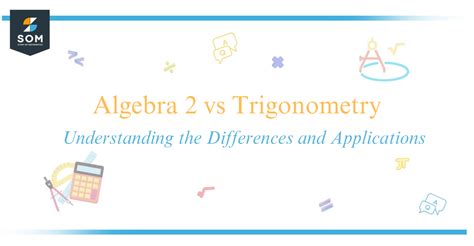In the vast realm of mathematics, calculus and trigonometry stand as two towering giants, each with a distinct set of principles, applications, and mathematical tools. While they share some common ground, these two disciplines delve into different aspects of mathematical analysis, offering unique perspectives on the quantification and study of the physical world.

Calculus emerged in the 17th century, spearheaded by the work of Isaac Newton and Gottfried Wilhelm Leibniz. It evolved from the ancient Greek concept of infinitesimals, providing a rigorous framework for measuring change and describing continuous functions.
Trigonometry, on the other hand, has roots in ancient Egypt and Mesopotamia, where it aided astronomers in understanding the motion of celestial bodies. Over the centuries, it developed into a sophisticated system for calculating angles and solving geometric problems.
Calculus
- Derivatives: Measuring the rate of change of a function.
- Integrals: Calculating the area under a curve or volume of a solid.
- Limits: Describing the behavior of a function as it approaches a specific value.
Trigonometry
- Angles: Measuring the size of an angle in degrees or radians.
- Trigonometric functions (sine, cosine, tangent): Relating the angles and sides of a triangle.
- Identities and relationships: Establishing mathematical equations involving trigonometric functions.
Calculus
- Physics: Describing motion, acceleration, velocity, and other physical phenomena.
- Engineering: Designing structures, optimizing processes, and analyzing fluid dynamics.
- Economics: Modeling market growth, forecasting financial trends, and managing resources.
Trigonometry
- Surveying and navigation: Determining distances, angles of elevation, and headings.
- Architecture: Designing buildings, bridges, and other structures with precise geometry.
- Astronomy: Calculating the position, orbit, and distance of celestial objects.
| Characteristic | Calculus | Trigonometry |
|---|---|---|
| Focus | Rate of change, continuous functions | Angles, triangles, and trigonometric functions |
| Tools | Derivatives, integrals, limits | Sine, cosine, tangent |
| Applications | Physics, engineering, economics | Surveying, navigation, astronomy |
| Mathematical Model | Continuous functions | Discrete angles and functions |
| Units of Measurement | Slope, area, volume | Degrees, radians |
- Both calculus and trigonometry are branches of mathematics.
- They use algebra and other mathematical concepts as building blocks.
- They have a rich history of development and applications.
- They are essential for understanding a wide range of scientific and engineering problems.
Calculus and trigonometry, while distinct in their approaches and applications, are indispensable tools in the mathematical toolkit. They provide essential insights into the quantification and analysis of change, geometry, and the physical world. Whether navigating celestial bodies, designing structures, or modeling economic trends, these two disciplines empower us to understand and solve complex problems with precision and elegance. By embracing the unique strengths of both calculus and trigonometry, we unlock a world of possibilities for mathematical discovery and technological innovation.
Further Exploration
- Visit the American Mathematical Society website for resources on calculus and trigonometry: https://www.ams.org
- Explore the Khan Academy’s online courses on calculus and trigonometry: https://www.khanacademy.org
- Dive into interactive calculus and trigonometry applications at the Desmos website: https://www.desmos.com
